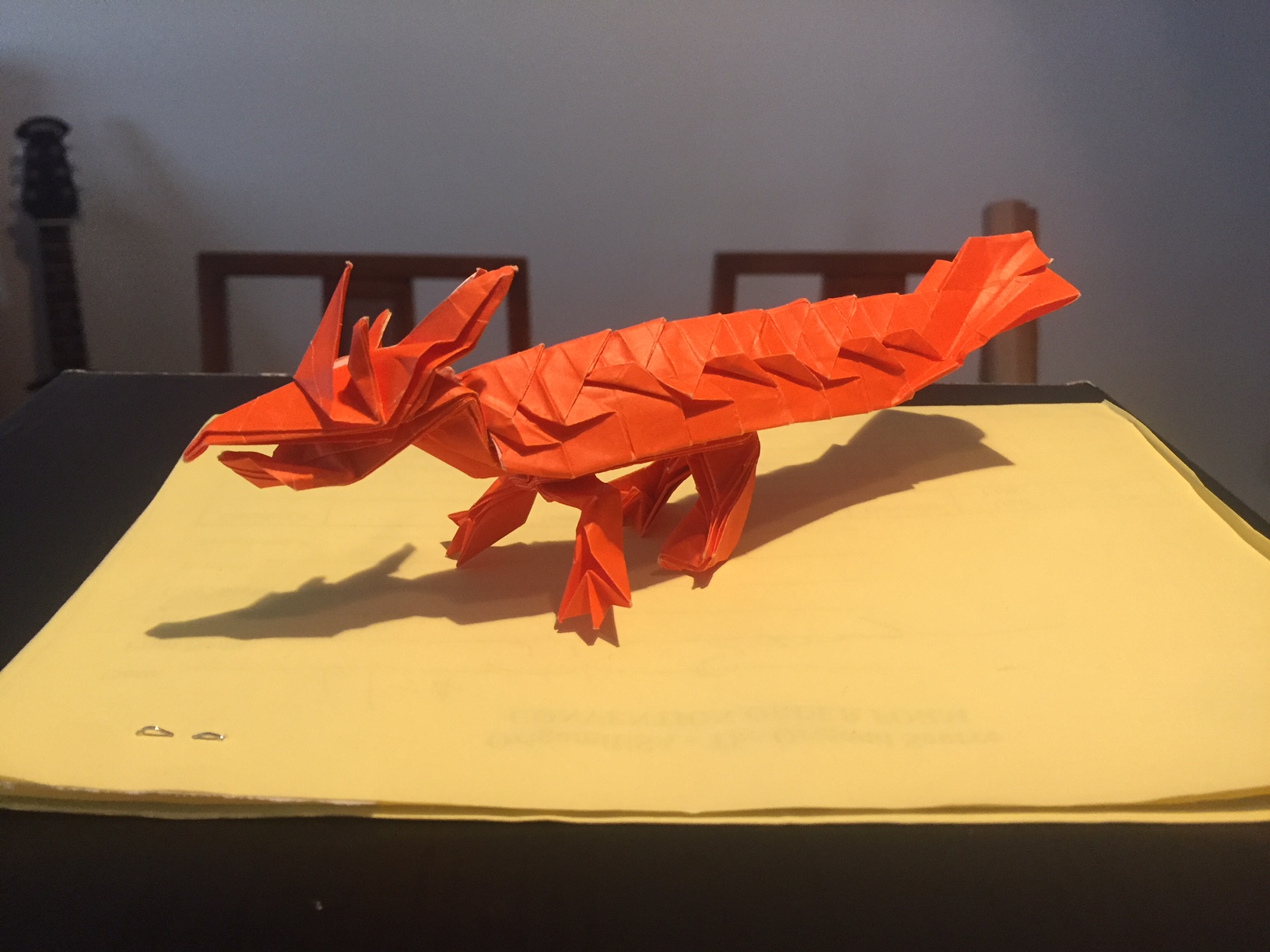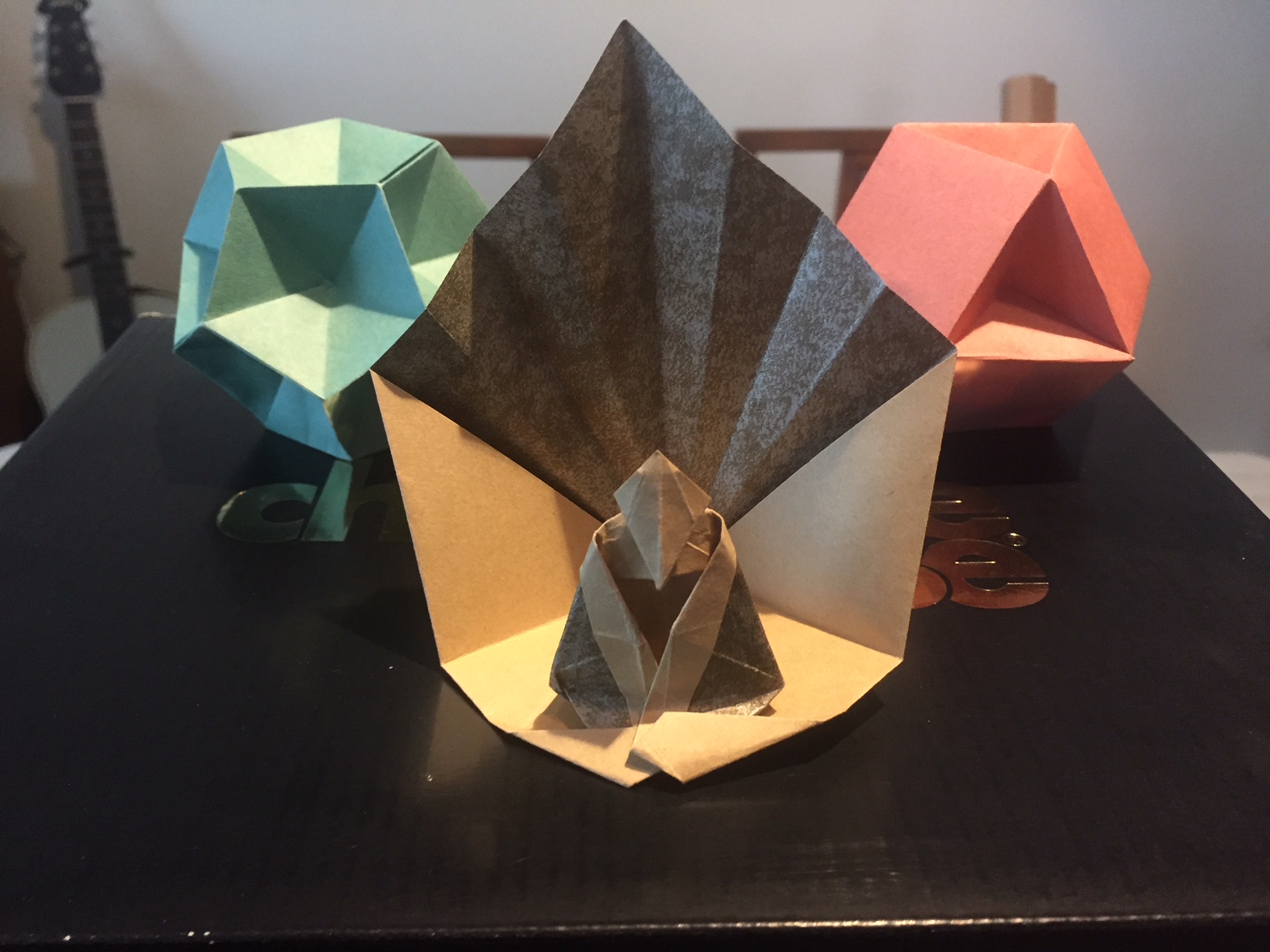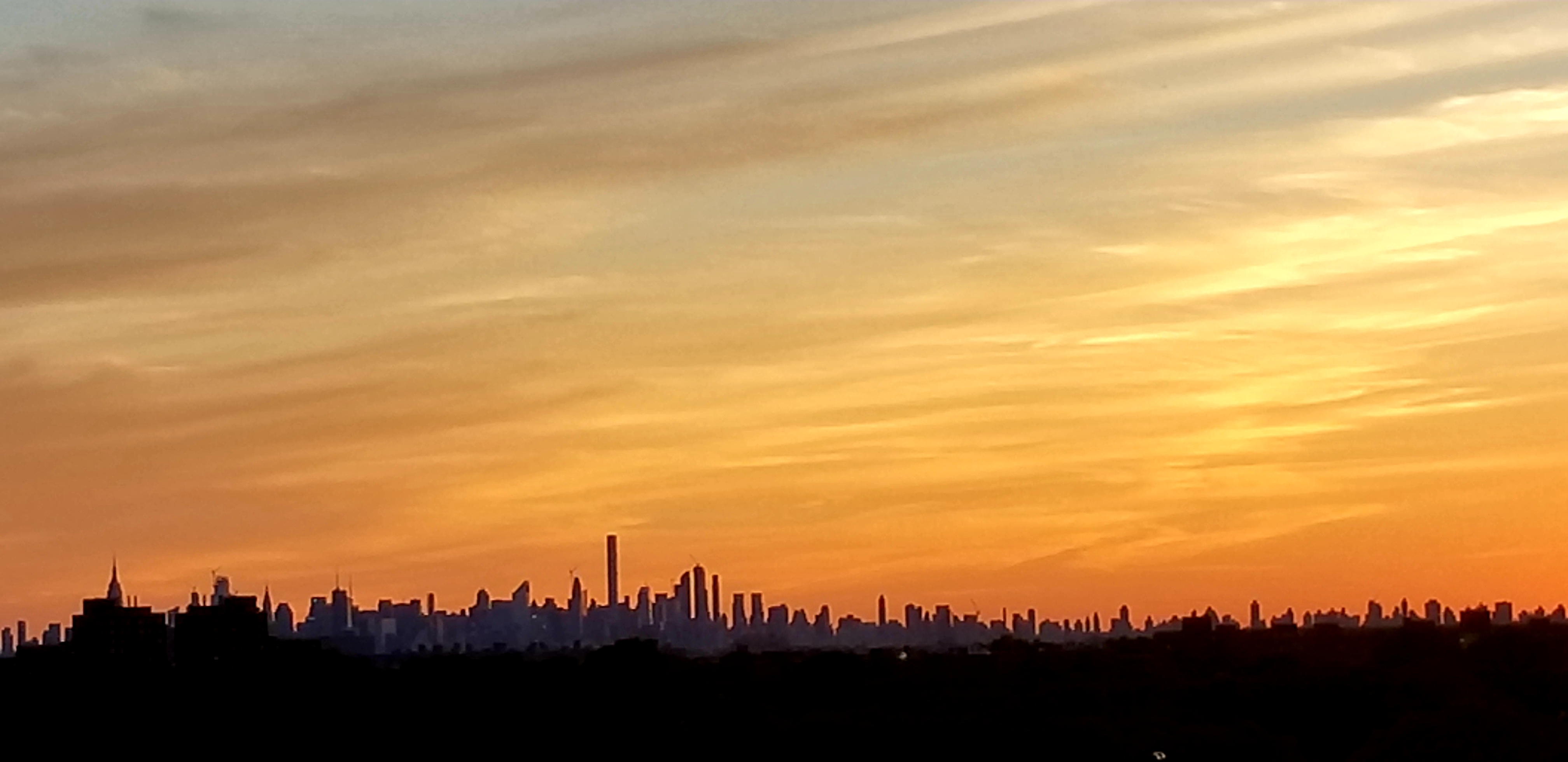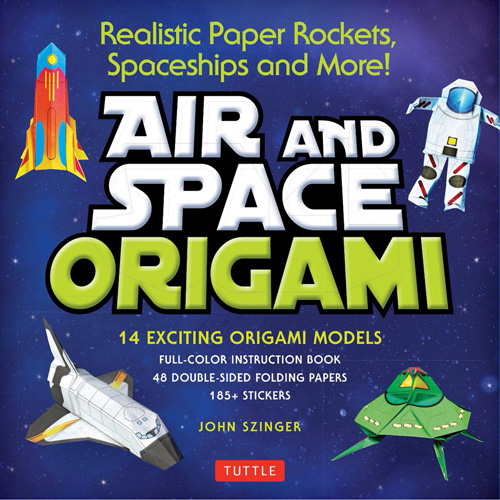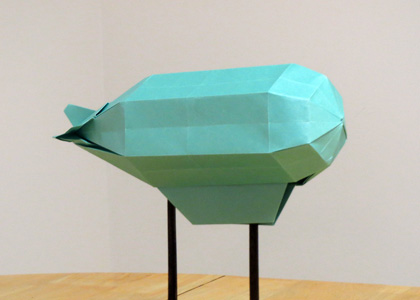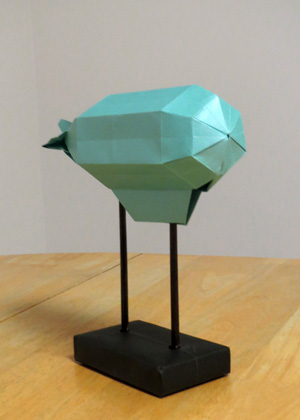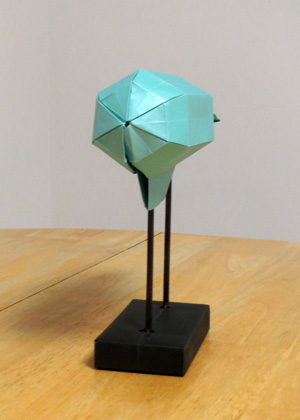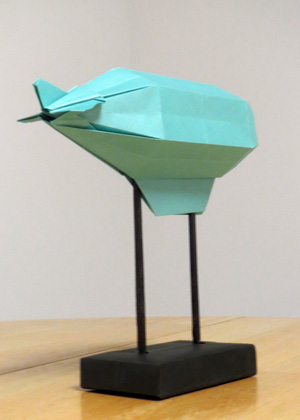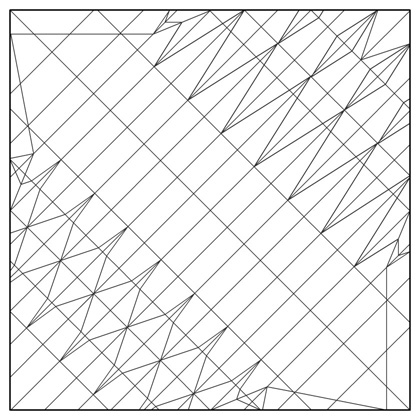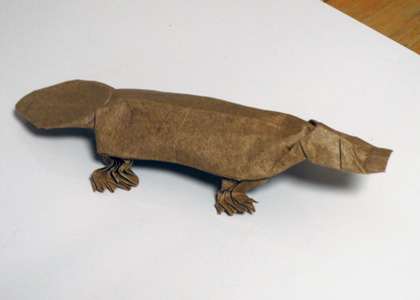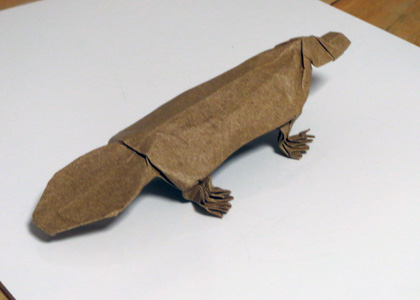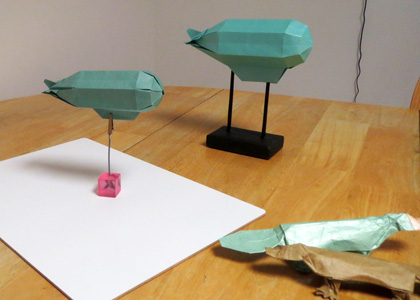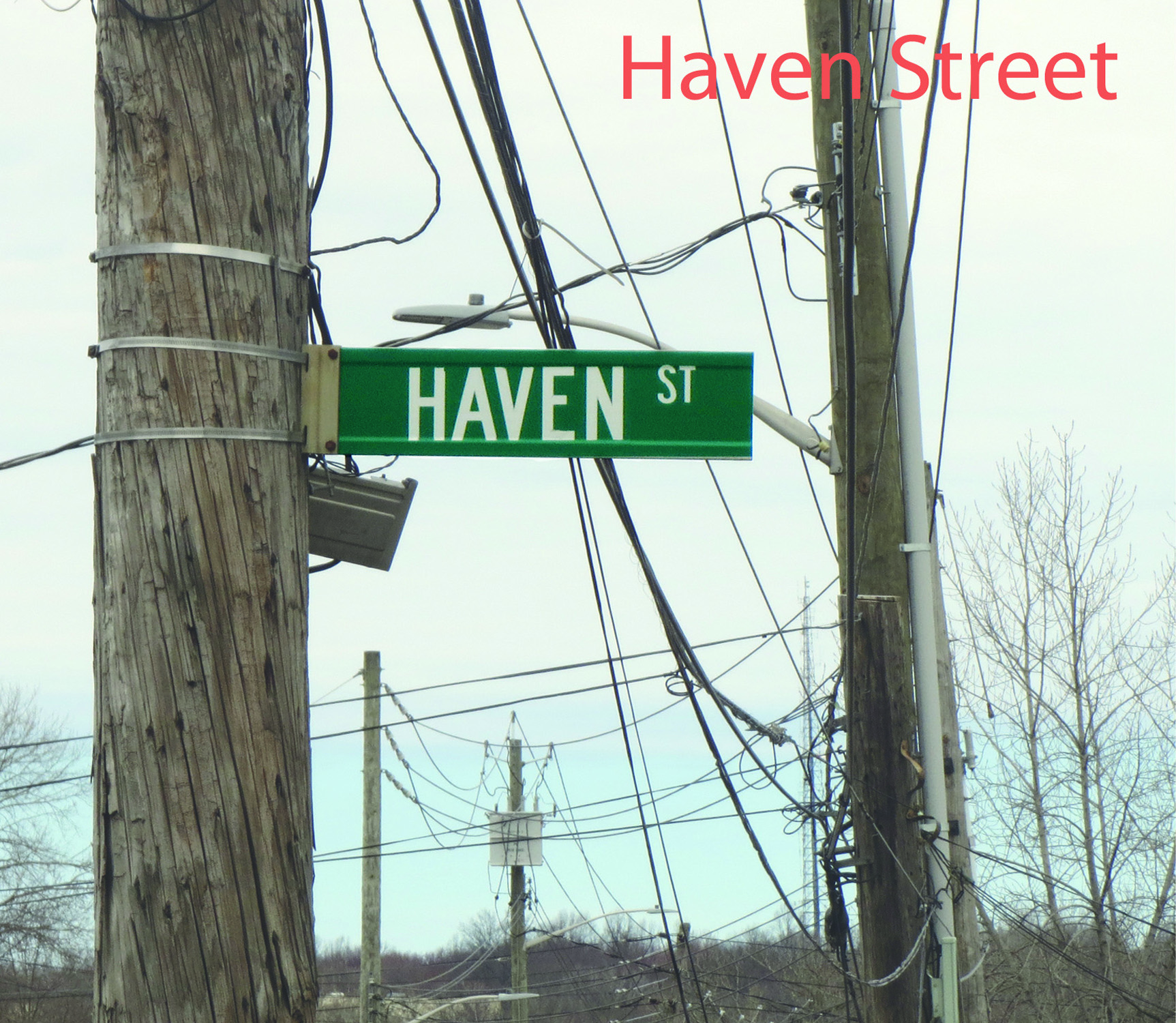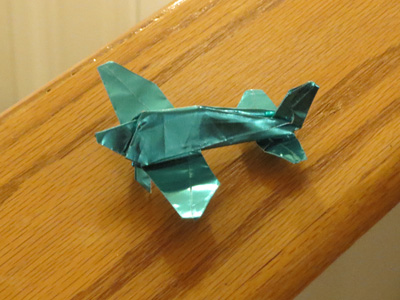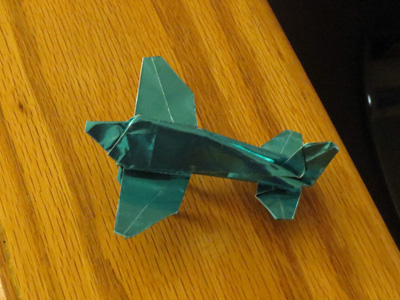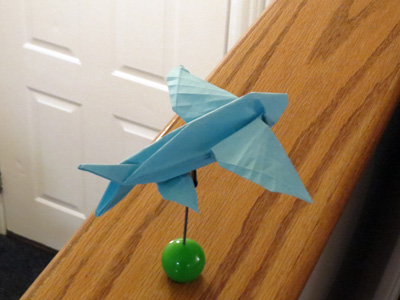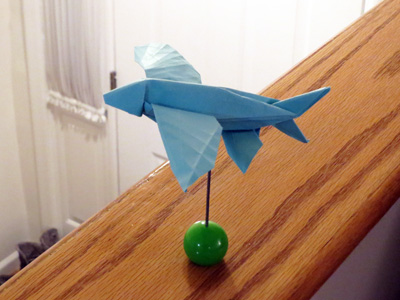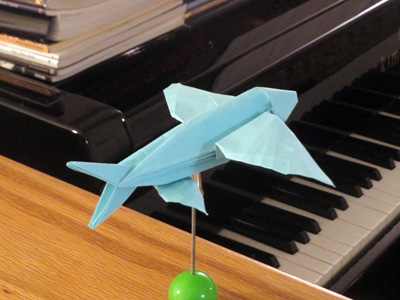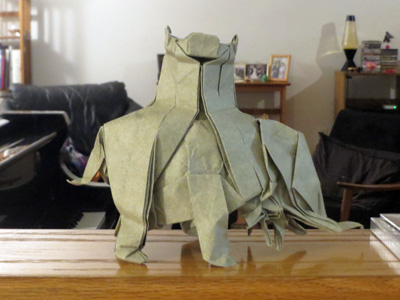I just got back from a great trip upstate and into Canada. More on that soon, but this post is about this year’s OUSA convention in NYC, which was now two weeks ago. For the last few weeks I’d been trying to make the time to develop to completion some ideas for some new models. I won’t say what all the unfinished work-in-progress ones are cuz I’m sure someday I’ll circle back to them.
One brand-new model I finished is my Platypus. It uses the hex base like my Lizard, Turtle, and Armadillo. The main challenge here was to get a good looking head (and as always the shoulders) including a color change for the bill.
The other one is my Blimp, a.k.a. Zeppelin II. A few years back I created a fully three-dimensional Zeppelin. It’s a pretty impressive model and was featured in several exhibits at the time. But although I liked the final form I was never truly satisfied because it was not very efficient in it’s use of paper, and it was very, very difficult to fold, and basically impossible to diagram. It employed the original Origami from Space approach I developed on my Rocketship and U.F.O., using a polar layout to create a round, voluminous form. I took that approach about as far as it could go.
When I did my airplanes and spaceships book I revisited some of these subjects and created much simpler forms that still captured the essence. Notably my Retro Rocket and Flying Saucer are foldable in about twenty minutes in less than 30 steps, compared to their archetypes, my Rocketship and U.F.O., which require an hour or two each, and whose diagrams run over 60 steps.
The new Blimp is also greatly simplified, requiring about an hour to fold, compared with several days, and the folding sequence is also streamlined, and doable from 10” paper. It has completely different plan. The main form of the model wraps around like a tube. I had tried this approach several times before but couldn’t get the nose or tail to lock, or the tail fins to be large enough. This time around I was able to somehow solve those problems easily.
I started on the blimp the Thursday night before the convention. It took a few iterations and I ended up staying up very late tweaking the proportions and trying different variations, but it was basically there. Friday daytime I folded an exhibit-quality model out of 35cm Marble Wyndstone to put into my display. There is still one little tweak I want to make to the underside of the nose to make the lock tighter. Then I’ll fold one out of some kind of shiny sparkly paper and diagram it.
With this model perfected, I have enough material to make a complex counterpart to my upcoming Origami from Air and Space book, coming out this fall. The idea would be to release an ebook of complex air and space themed models including the new Blimp, the Rocketship and U.F.O.and the Biplane. These are all great models. The others were originally slated for the print book before the focus shifted to a broader audience, and are already diagrammed.
Fortunately my agreement with my publisher is print-only. I can do whatever I want online or as an e-book. I think the two titles will complement each other nicely. There is an audience of advance folders out there who are really hungry for good material. If it works out I have several other topics’ worth material I can use in this way.
The convention itself was alot of fun. My main thought is that it always comes and goes so quickly! It’s always such an intense experience, like being teleported into another world. It’s great to re-connect with my origami friends, and I always come away with lots of new ideas I want to follow up on. I wish I had more time in my life to do more origami. Ah well, someday.
One source of new ideas came from John Montrol, who often comes with diagrams for new unpublished books. This year’s batch was complex single-sheet polyhedra. The whole collection was great, but in particular a couple variations on the Dodecahedron and Cuboctahedron stood out, nicely foldable from a 9” square.
Another great model came from Jason Ku. It was some kind of oriental dragon, inspired by Satoshi’s classic Eastern Dragon, but simplified, taking only about 5 hours to fold rather than months and months. It’s a really beautiful and impressive model. Jason came to Michelle and me Saturday morning, wanting to try out teaching it to us so he could prepare for his class. It starts by folding a 32×32 grid, and from there develops the tessellation that is the dragons’ scales on it’s body and tail. This took about 3 hours and was all had to go to lunch and on to other classes.
Jason was teaching it again Saturday night, and Michelle and I dropped midway thru, only to be told we should come back later. So we did, and we got thru the next section, developing the base for the head and legs. It was mainly box pleating, and I learned a new technique called Wizard Fingers, apparently developed by Satoshi for the hands of his Wizard. Finally Sunday night Michelle and I tracked Jason down and he showed us the sculpting and finishing for the head, legs and whole body.
Every time we go to an origami event Michelle levels up. She’s now capable of folding stuff like this. She says next year she wants to teach and possibly exhibit.
A third source of inspiration came from Viviane Berty from France, a convention special guest. She has a very flowing and sculptural folding style. I took her Monday class, about origami design. I always like taking origami design classes because it reveals so much about the designer. She is a very knowledgable and friendly person. She talked about getting to the essence of the form, and used a couple of her models as examples. Then she had everyone do a exercise of trying to come up with a bird or animal in as few folds as possible. I had come in already folding something, so I just stopped were I was a and had a airplane. I also came up with a pretty nice Hawk, based on an idea I had once before and developed a little further. Other people in the class came up with some other good ideas. Making a pretty good simple model is not that hard, but making a really great one is far from easy.
As it turned out Viviane had a few of her models in the convention book, so I folded those later in the day. My favorite was her Buddha, which was a compound model with a robed, meditating figure and a radiating pattern in the background. Similar in approach to my Martian.
Of course we went to the shop for paper and books. I now have a new favorite kind of paper, It’s called Vintage and it’s available from origamishop.us. It’s almost like a really thin Elephant Hide. It’s just a bit thicker than Kami, but much stronger and crisper, and the same color on both sides. It comes in a nice array of colors, subtle not garish, with a texture that suggest the finished model might be carved out of stone. Available in 9” and 15” sheets, and not crazy expensive. A good general purpose paper. We folded so much that we went back and bought some more, and then went back the last day and bought out the rest of their stock.
I also bought Robert Lang’s new book Twists, Tilings and Tessellations. At 700 pages it’s a massive tome on the level of Origami Design Secrets, full of math and theory. Should keep me busy for a while.
As always, I taught a few classes. This year I did my Butterfly II, which is a fairly accessible high-intermediate model. The class was quite full and went well. The next day I taught my Flying Fish, which is a new model from last winter. I accidentally gave a wrong direction about halfway through, which caused some confusion and cost some time to straighten out, so we barely finished on time. Still, all in all it was okay and everyone finished with a successful model.
Later on outside of class a couple of kids came up to me and asked me to sign their copies of my book. They asked me to teach them something so I had them do my new Platypus.
Up at the exhibit hall I met a folder name Boice who told me that my original dragon, whose diagrams have been online for many years, was one of his favorite and most influential models. So I sent him the diagrams for my Medieval Dragon, which is an evolution of the dragon on my web site, with a more detailed head and wings, and is currently unpublished. I may put it into an ebook for supercomplex fantasy models, along with my War Elephant and Random Monster Generator.
Finally, for years I’ve been working on-and-off on origami simulation and diagramming software, although recently it’s been more off than on. I met a guy name Robby Kraft who has an origami simulator based on javascript. You can see a demo at rabbitear.org. He’s using Jason Ku’s FOLD schema to represent the model as json. Really good stuff.
His project is open source and I’m trying to figure out a way to collaborate/contribute. I’ll probably start by taking some some of my crease patterns and feeding them into his system. He’s getting it on github with feature requests, so hopefully I can just pick something small to work on as a way into getting to know the code base. We’ll see how it goes. As I said, I wish I had more time for origami.
